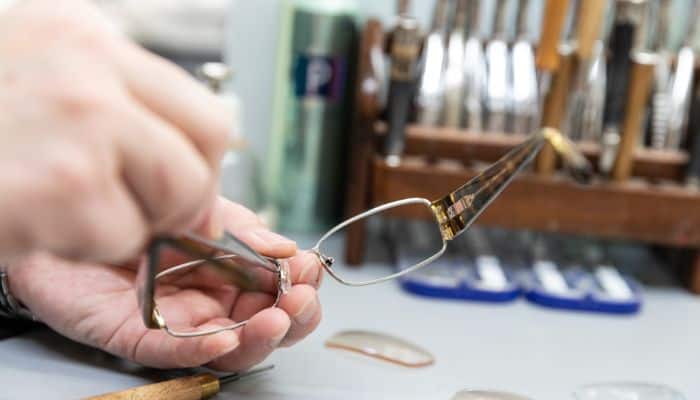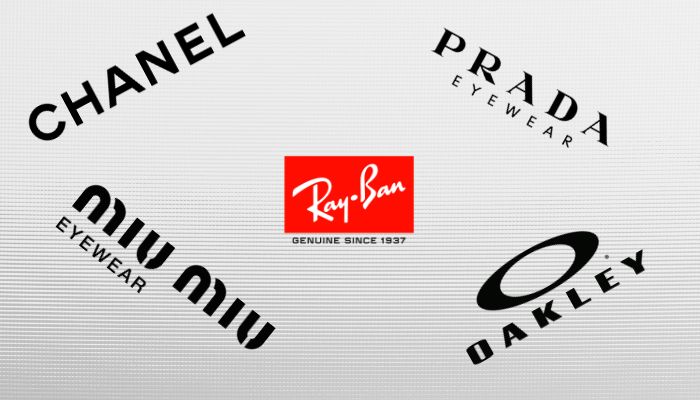If you’ve ever shopped around for a pair of glasses, you know that they can be quite expensive. But why? After all, they’re just some small pieces of plastic and a couple lenses, right? It’s not like they’re made out of gold!
Let’s take a look at the various factors that explain why glasses can cost so much.
(This page contains affiliate links. OGR may receive compensation if you click a link and make a purchase.)
Materials
Obviously, one of the fundamental costs involved in producing eyeglass frames and lenses are the actual materials.
But with advances in technology and manufacturing, these costs are actually quite low in comparison to the total cost of a pair of glasses.

Frames and lenses today are often made from polycarbonate and other plastics, which used to be expensive but are now readily available on the market at relatively inexpensive prices.
Sure, there are definitely some premium materials like titanium frames or glass lenses, which are more expensive, but if you’re not purchasing these types of frames and lenses, chances are, the material cost is not a major factor in the price of your glasses.
So if the cost of materials is fairly negligible, what else could be driving up the prices of glasses?
Are Expensive Eyeglass Lenses Worth It?
Labor, Design and Manufacturing
Today’s frames are often works of art, featuring intricate designs and beautiful finishes. But modern designs don’t come easily – they require a creative process, which includes concept development, prototyping, tooling and final production.
The manufacturers have to pay for the time and effort of the engineers and designers who create these fantastical frames.
In addition, the production process itself is complex. From 3-D printing to injection molding, it takes a good amount of investment to bring all the pieces together.
Plus, there are all sorts of quality control checks that need to be done in order to make sure the frames and lenses meet the required standards.

When it comes to prescription lenses, remember that these are medical devices, not just a simple piece of plastic.
Special machinery and technology is needed to grind and polish the lenses, as well as apply any necessary coatings or treatments (like anti-reflective coating, for example).
Lens manufacturers also use advanced technologies like digital surfacing, which creates lenses that are highly precise and tailored to each individual’s vision needs.
This process is expensive, but it results in better vision correction.
Ok but still, aren’t improvements in technology and design also coupled with decreasing costs?
Does the cost of designing and producing eyeglasses en masse really incur the kind of crazy markups we often see?

Marketing and Distribution
Just like any other product, eyewear companies have to market and distribute their products.
Companies invest in advertising campaigns, promotions, and retail locations to get their product in front of customers.
Plus, there are costs associated with transport and storage, particularly if an optical shop outsources the production of lenses and frames.
But again, does this explain why an off-the-shelf pair of glasses with prescription lenses can cost upwards of $400, $600, or more?
The Eyewear Monopoly

One of the ugly secrets of the eyewear industry is that there is really only one large conglomerate – EssilorLuxottica – controlling the market. As the 800-lb. gorilla in the room, they have no incentive to lower prices.
By maintaining a monopoly on the eyewear industry, they can set high prices for their products and make huge profits.
Not only do they own popular brands like Ray-Ban, Oakley, and Persol, but they also have licenses for the likes of Chanel, Prada, Armani, and many more.
In addition to most of the well-known eyewear brands, Luxottica also owns many optical chains (including Pearle Vision and Sunglass Hut) – which means they’re able to exclude other eyewear brands from competing against their brands in these stores.
Popular lens manufacturers like Crizal™ and Transitions™ also fall under the Luxottica group.
As you can see, when the entire supply chain is owned by one conglomerate, they can set high prices (that consumers have no choice but to pay) and make huge profits in the process.

Without competition, prices remain high and there’s no incentive to lower them – leaving you, the consumer, paying more for your glasses than you really have to.
Are You Really Stuck With Exorbitant Prices for Eyeglasses?
Now that you know why the cost of a new pair of eyeglasses is so high, you’re probably wondering if there’s any way to get a pair of glasses without breaking the bank.
The good news is that there are plenty of options available for those who want to save some money on prescription eyewear.
Most retail or big box opticals such as America’s Best, Costco Optical or VisionWorks have reasonable pricing on frames and lenses, and may even offer discounts or special deals for multiple pairs of glasses, as well as special promotions that may include free lenses or frames.
You can also find great deals online at sites like EyeBuyDirect, Zenni Optical, GlassesUSA and 39 Dollar Glasses.
Try 5 Pairs On For Free At Home
These companies are able to keep their costs down by designing, producing and selling direct-to-consumer products within their own supply chain, with no middlemen or high markups.
Finally, you can check out your local optical shop or search online for independent eyewear retailers who offer great designer styles without the high price tag.
So, while the eyewear industry may be dominated by one large conglomerate, there are still plenty of options available for those who want to save money on their glasses without sacrificing quality or style.
Whether you’re looking for designer frames or just a basic pair of prescription lenses, with a bit of research you can find the perfect pair of glasses at a price that won’t break the bank.